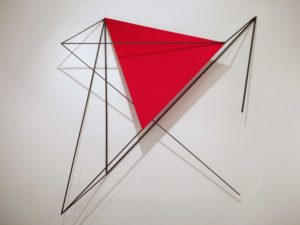 In its last year’s spring exhibition the gallery Spazio Testoni in Bologna presented the works of the Italian neo-constructivist Alberto Zilocchi (1931-1991). It was his first post mortem solo show. This year the gallery rediscovered a companion of Zilocchi, Paolo Ghilardi (1930-2014). However, if that would not be enough, Paola Veronese from Spazio Testoni and Maurizio De Palma from the “Archivio Paolo Ghilardi e Alberto Zilocchi” collated the oeuvres of these two artists to the ones of another companion, Marcello Morandini (1940) to an exhibition in the archives seat in Milan. Moreover, the three brothers in art will be on show during the Berlin Gallery Weekend at the Werkstattgalerie.
In its last year’s spring exhibition the gallery Spazio Testoni in Bologna presented the works of the Italian neo-constructivist Alberto Zilocchi (1931-1991). It was his first post mortem solo show. This year the gallery rediscovered a companion of Zilocchi, Paolo Ghilardi (1930-2014). However, if that would not be enough, Paola Veronese from Spazio Testoni and Maurizio De Palma from the “Archivio Paolo Ghilardi e Alberto Zilocchi” collated the oeuvres of these two artists to the ones of another companion, Marcello Morandini (1940) to an exhibition in the archives seat in Milan. Moreover, the three brothers in art will be on show during the Berlin Gallery Weekend at the Werkstattgalerie.
Paolo Ghilardi abandons the canvas
In contrast to Zilocchi, who worked mainly in white, Ghilardi’s creations are largely colourful. By their form, the last year exhibited “Rilievi e Linee” (Reliefs and Lines) reminded the classical panel painting, even though they are abstract reliefs on wood or pen on acrylic. Whereas Ghilardi’s “Traiettorie Policrome” (Polychrome Trajectories) frequently abandons the classical image space.
This is particularly evident in the entrance room, where a huge environmental installation made of numerous coloured light metal foils captures the space. The triangles and rectangles are spread over the walls and floor, so that the visitor plunges directly into the artwork. With this installation Ghilardi stepped out of the limited image space in 1976. First presented by the Lorenzelli Gallery in Bergamo in 1976, it was literally the artists breaking out of the limits of the canvas. A complement is made by two Plexiglas architectures from the 1990s.
However, the second and the third room are revealing more classical, acrylic paintings, all geometrical compositions from the 1970s. They are reminding sometimes the former TV test images. Even though some of them seem trying to burst out of the image space.
The collages in the last room from the 1990s and the beginning 21st century are illustrating Ghilardi’s research in the three-dimensional. They are white and coloured geometrical forms cut out of paper layered in Plexiglas boxes. Most of them are not really collages in the strict meaning of the term, because they are not fixed by glue. The paper pieces are put loosely in superposition and only held by the box.
Another break out of the canvas represents “FE/TST 9” from 1994 in the same room. A red textile triangle surrounded by black metal sticks forming more triangles, is a final highlight of the exhibition. It displaces the limits between painting and sculpture. In addition, there are several catalogues on view, a small documentation of Ghilardi’s exhibitions.
international workgroup for constructive art
Founded in 1972 by Pierre de Poortere, HD Schrader and Guy Vandenbranden, the “international workshop for constructive art” in Antwerp and Bonn, was active until the 1980s. Joined by many other European artists, they organised exhibitions and symposiums. Their objective was to develop and present “thematically oriented work programmes executed by a changing array of artists”. (http://www.iafkg.com/index.html) Since there was no mandatory formulated program, the members conserved their independence and the movement attracted many artists who felt concerned by constructivism. Therefore, the group of steady participants in the events of the workgroup was much larger than the number of subscribed members. Paolo Ghilardi, AlbertioZilocchi and Marcello Morandini attended and supported these activities for many years. Now their works are once again together on display.
The exhibition: internationaler arbeitskreis für konstruktive gestaltung
The space of the “Archivio Paolo Ghilardi e Alberto Zilocchi” are originally functional offices. In consequence, an orchestration like at Spazio Testoni is not possible. Nevertheless, the artworks are enriching the rooms and adapt themselves into their new environment. Due to this situation, the chosen oeuvres are mostly fixed at the walls. Only some sculptures found their way into niches, where they refine the atmosphere.
Since the artists guarded their artistic individualities, despite their common projects with the international workshop for constructive art, the artworks function differently in the location. Alberto Zilocchi’s black and white pen drawings are fitting optically and by their materiality perfectly into an office. The monochrome reliefs are delicate elevations on the white walls. Whereas Paolo Ghilardi’s colourful paintings contrast to the background and at the same time to the minimalistic creations of his companion. They are colour spots in this ambiance. However, there are some Ghilardi’s, which remind to his colleague: white dominated, with some restrained colour insertions.
Marcello Morandini built a bridge between his two associates, especially in view of Ghilardi’s spatial outbreaks, which we saw in Bologna. His works in the show repeat the white and black from Zilocchi, yet they are reliefs, if not sculptures. They have a material presence, even more than the extensive installation by Ghilardi. Morandini combines the black and white equally together like Ghilardi in his earlier paintings. It would be interesting to see these artworks communicate in an empty space. On to the next encounter at the Werkstattgalerie in Berlin!
Spazio Testoni
“Traiettorie Policrome”
18 March – 30 June 2017
Via D’Azeglio 50, Bologna
Archivio Alberto Zilocchi e Paolo Ghilardi
“internationaler arbeitskreis für konstruktive gestaltung“
29 March – 30 June 2017
Via Monte Rosa 13, Milan
Werkstattgalerie
“internationaler arbeitskreis für konstruktive gestaltung“
27 April – 26 May 2017
Eisennacher Strasse 6, Berlin
http://www.werkstattgalerie.org






























